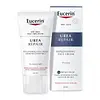What's inside
What's inside
 Key Ingredients
Key Ingredients

 Benefits
Benefits

 Concerns
Concerns

 Ingredients Side-by-side
Ingredients Side-by-side

Water
Skin ConditioningPropanediol
SolventCetyl Ethylhexanoate
EmollientDibutyl Adipate
EmollientHydrogenated Polydecene
EmollientCoco-Caprylate/Caprate
EmollientPanthenol
Skin ConditioningPolyglyceryl-6 Stearate
EmollientGlycerin
HumectantBeeswax
Emulsion StabilisingCetearyl Alcohol
EmollientNiacinamide
SmoothingPalmitic Acid
EmollientStearic Acid
CleansingButyrospermum Parkii Butter
Skin ConditioningGlyceryl Stearate
EmollientSodium Acrylate/Sodium Acryloyldimethyl Taurate Copolymer
Emulsion StabilisingCaprylyl Glycol
EmollientIsohexadecane
EmollientLeontopodium Alpinum Extract
Skin ConditioningPolyglyceryl-6 Behenate
Emulsion StabilisingEthylhexylglycerin
Skin ConditioningCarbomer
Emulsion StabilisingTromethamine
BufferingHydrogenated Olive Oil Unsaponifiables
EmollientOryza Sativa Lees Extract
Skin ConditioningTocopheryl Acetate
AntioxidantPolysorbate 80
Emulsifying1,2-Hexanediol
Skin ConditioningAdenosine
Skin ConditioningSorbitan Oleate
EmulsifyingCitric Acid
BufferingSodium Benzoate
MaskingPotassium Sorbate
PreservativeHydrolyzed Soy Flour
Skin ConditioningBuddleja Davidii Extract
Skin ConditioningThymus Vulgaris Extract
PerfumingWater, Propanediol, Cetyl Ethylhexanoate, Dibutyl Adipate, Hydrogenated Polydecene, Coco-Caprylate/Caprate, Panthenol, Polyglyceryl-6 Stearate, Glycerin, Beeswax, Cetearyl Alcohol, Niacinamide, Palmitic Acid, Stearic Acid, Butyrospermum Parkii Butter, Glyceryl Stearate, Sodium Acrylate/Sodium Acryloyldimethyl Taurate Copolymer, Caprylyl Glycol, Isohexadecane, Leontopodium Alpinum Extract, Polyglyceryl-6 Behenate, Ethylhexylglycerin, Carbomer, Tromethamine, Hydrogenated Olive Oil Unsaponifiables, Oryza Sativa Lees Extract, Tocopheryl Acetate, Polysorbate 80, 1,2-Hexanediol, Adenosine, Sorbitan Oleate, Citric Acid, Sodium Benzoate, Potassium Sorbate, Hydrolyzed Soy Flour, Buddleja Davidii Extract, Thymus Vulgaris Extract
Water
Skin ConditioningGlycerin
HumectantUrea
BufferingCetyl Alcohol
EmollientCaprylic/Capric Triglyceride
MaskingPentaerythrityl Tetraisostearate
EmollientTriisostearin
Skin ConditioningSodium Lactate
BufferingGlyceryl Stearate
EmollientArginine Hcl
Skin ConditioningDimethicone
EmollientPotassium Cetyl Phosphate
EmulsifyingXanthan Gum
EmulsifyingBiosaccharide Gum-1
HumectantLactic Acid
Buffering1,2-Hexanediol
Skin ConditioningPhenoxyethanol
Preservative
 Reviews
Reviews

Ingredients Explained
These ingredients are found in both products.
Ingredients higher up in an ingredient list are typically present in a larger amount.
1,2-Hexanediol is a synthetic liquid and another multi-functional powerhouse.
It is a:
- Humectant, drawing moisture into the skin
- Emollient, helping to soften skin
- Solvent, dispersing and stabilizing formulas
- Preservative booster, enhancing the antimicrobial activity of other preservatives
Glycerin is already naturally found in your skin. It helps moisturize and protect your skin.
A study from 2016 found glycerin to be more effective as a humectant than AHAs and hyaluronic acid.
As a humectant, it helps the skin stay hydrated by pulling moisture to your skin. The low molecular weight of glycerin allows it to pull moisture into the deeper layers of your skin.
Hydrated skin improves your skin barrier; Your skin barrier helps protect against irritants and bacteria.
Glycerin has also been found to have antimicrobial and antiviral properties. Due to these properties, glycerin is often used in wound and burn treatments.
In cosmetics, glycerin is usually derived from plants such as soybean or palm. However, it can also be sourced from animals, such as tallow or animal fat.
This ingredient is organic, colorless, odorless, and non-toxic.
Glycerin is the name for this ingredient in American English. British English uses Glycerol/Glycerine.
Learn more about GlycerinGlyceryl Stearate is a mix of glycerin and stearic acid.
It is used to stabilize the mixing of water and oil ingredients. By preventing these ingredients from separating, it can help elongate shelf life. It can also help thicken the product's texture.
As an emollient, it helps soften skin and supports barrier-replenishing ingredients.
In cosmetics, Glyceryl Stearate is often made from vegetable oils or synthetically produced.
This ingredient may not be fungal-acne safe
Fun fact: The human body also creates Glyceryl Stearate naturally.
Learn more about Glyceryl StearateWater. It's the most common cosmetic ingredient of all. You'll usually see it at the top of ingredient lists, meaning that it makes up the largest part of the product.
So why is it so popular? Water most often acts as a solvent - this means that it helps dissolve other ingredients into the formulation.
You'll also recognize water as that liquid we all need to stay alive. If you see this, drink a glass of water. Stay hydrated!
Learn more about Water